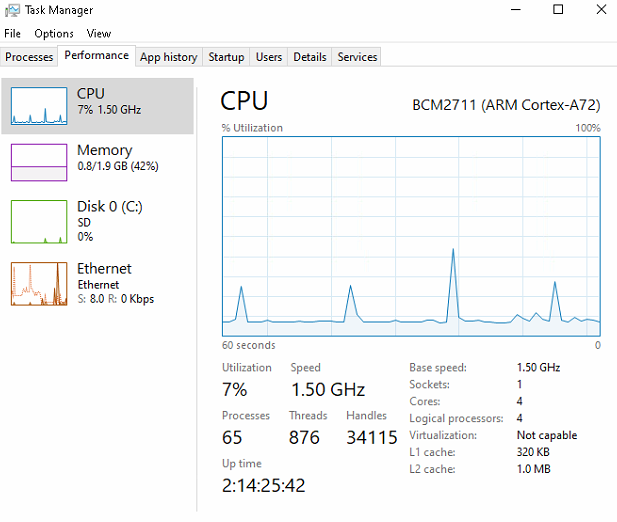Performance Limitations
Running Windows 10 on your Raspberry PI has a few primary limitations
Limitations across the board
- SD card performance
- On top of poor read/write performance of around 12MB/s, the random read/write are even slower at about 4MB/s, which causes the OS to feel slow and sluggish, especially with Windows 10 as it likes to run lots of things in the background.

- Graphics Drivers
- They don’t exists! Well, no in any useful capacity. There is a rpi-gpu driver for windows 10 on the PI 3, but there isn’t really anything useful done to it. PI 4 has nothing atm.
- Non-native apps
- Not very many apps are native to ARM64 yet, which means software emulation must be used, taking up around 30% of the CPU performance and causing slow downs.
Limitations on the Raspberry PI 3
- CPU
- The CPU in the PI 3 is quite slow by today’s standards. Although it is fast enough for basic tasks, it quickly becomes overpowered by anything heavy tasked, but it’s far from the biggest issue with the PI3
- RAM
- The PI 3 has very little ram for an operating system like Windows, and in it’s stock form you will find the RAM to be completely full almost all of the time.
Limitations on the Raspberry PI 4
- RAM
- If you own a 2GB PI 4 you’ll be on the bare minimum amount of RAM, which may become a bottleneck for you. However, the SD card performance is a far bigger issue than this.
Optimizing Windows 10
If you want the best experience running windows 10 on the PI, you’ll want to optimize the install so it preforms best.
Optimization Script
I’ve been maintain a script that makes a huge difference on such a low performance device such as the PI. Here’s the basics of what it does
- Disables many services, around 85. These have been carefully picked so 99% of the population would never notice the difference. Most of these services were used for data collection and telemetry.
a. SuperFetch is disabled in this. If you are on an older build of windows 10 (1803 for example), you may find memory compression to be turned off. Fix this by updating windows or reenable SuperFetch. - Patch to block telemetry and tracking, increasing user privacy and taking things out of the background.
- Disable and Uninstall OneDrive
a. It uses a lot of memory and disk, if you need it you can simply reinstall it. - Removes around 40 built in garbage apps
- Blocks apps installed as an advertisement
a. Not only do I have a huge gripe with Microsoft about this, but it takes of disk performance in the background and is easily noticeable. - If you are on windows 2004, Cortana is finally completely removed from the system, now is the time to rejoice
- Disabled “windows 10 experiments”
Bellow is an example of idle usage on a 2GB PI4 after running the script.
